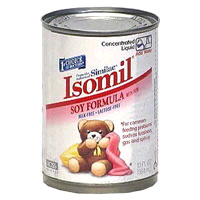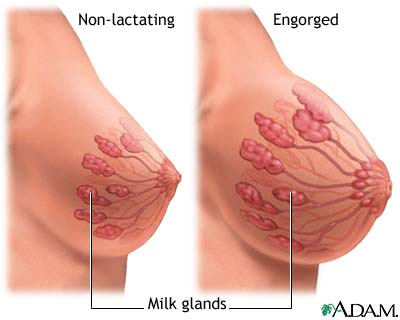It looks like you're using an Ad Blocker.
Please white-list or disable AboveTopSecret.com in your ad-blocking tool.
Thank you.
Some features of ATS will be disabled while you continue to use an ad-blocker.
0
share:
Should we worry about soya in our food?
Whether you know it or not, you'll probably be eating soya today. It's in 60% of all processed food, from cheese to ice cream, baby formula to biscuits. But should it carry a health warning? Felicity Lawrence investigates...
Over the next months, Fitzpatrick carried out an exhaustive study of soya and its effects. "We discovered quite quickly," he recalls, "that soya contains toxins and plant oestrogens powerful enough to disrupt women's menstrual cycles in experiments. It also appeared damaging to the thyroid." James's lobbying eventually forced governments to investigate. In 2002, the British government's expert committee on the toxicity of food (CoT) published the results of its inquiry into the safety of plant oestrogens, mainly from soya proteins, in modern food. It concluded that in general the health benefits claimed for soya were not supported by clear evidence and judged that there could be risks from high levels of consumption for certain age groups. Yet little has happened to curb soya's growth since.
More...
Wonderful...
I have heard about the estrogen in Soya many years ago, which is why I avoid it today, lately the girlfriend has been trying soya milk, don't know
how that would affect reproductive health. I should get her to read up on it.
Isn't Tofu from soya?
I wonder how levels of consumption would affect a male foetus and his reproductive organs?
On another note, I will still use soya sauce on my chinese dinners, Yum!
Isn't Tofu from soya?
I wonder how levels of consumption would affect a male foetus and his reproductive organs?
On another note, I will still use soya sauce on my chinese dinners, Yum!
The director of reproductive medicine at Queen's University, Belfast, Dr Sheena Lewis, said the findings were clear.
"What we have shown is that if men are consuming large amounts of soya products, for example, there is a negative relationship between that and the quality of their sperm.
"If they already have a slight problem in that area, then it might be better for them not to consume so much."
Dr Lewis said that the way to avoid excess oestrogen was to eat fresh produce.
news.bbc.co.uk...
I had heard about this before, so I took a look on Google.
There is an issue with soy products and the reproductive development in males.
When you consider the number of products that now contain soya in the western diet, this gets a bit frightening.
Vegetarian mothers seem more likely to have a baby born with a genital defect than meat-eating mothers – (first issued to the Press in February 1999).
University researchers in an investigation of more than 7,900 mothers found that vegetarians were nearly five times more likely to give birth to a boy with a malformed penis – a condition known as hypospadias.
Now the team at Children of the 90s child health project, say that more research is needed to support their finding or to show that it is a “rogue result”.
They stress that although only 51 boys were found with the abnormality the numbers were statistically significant.
www.alspac.bristol.ac.uk...
Hypospadia can be corrected with a simple operation, but if soya is causing the deformity we should be thinking about this before the pregnancy.
Who wants their son born with a deffect that won't allow him to aim straight ???
EDIT:
The list of concerns about soya-based artificial baby milks is extensive: the high levels of phytoestrogens, the possible presence of genetically modified (GM) soya, the glucose content and the large quantities of metals such as aluminium, not to mention the fact they do not contain any of the health-protecting immune factors and live cells that breast milk has in abundance (New Zealand Ministry of Health, 1998; Baby Milk Action, 1994).
It is estimated that 2% of all infants in the UK are fed soya-based milks (Ministry of Agriculture, Fisheries and Food (MAFF), 1998; Hamlyn et al, 2002). The soya-based baby milk market in the UK is worth approximately £6 million (the total baby milk market is worth over £150 million (Unsworth, 1998)).
www.babymilkaction.org...
Nature came up with a great solution for feeding babies.

Breasts are not sex toys for grown men to play with.
They have a purpose.

If they were used a bit more for that purpose all our offspring would be better off.
Boobies are for babies......................
[edit on 30/7/2006 by anxietydisorder]
This is the list of ingredients in Isomil.
These are the components in breast milk.
I see no valid reason to feed a newborn anything other than what nature intended.
The human female breast was intended to feed their offspring and anything else is a very poor simulation. (ie. Simulac)
The same goes for cows milk.
Our infants don't need to be sucking on the teats of another species for sustenance.
Just imagine your child suckling from one of these...

I think it's time for mothers to get back to providing the proper diet for their infants.
There is no shame or embarrassment in exposing a breast in public to feed your child, and I think that stigma is something unique to North America.
And that's a shame. :shk:
I'll re-visit this topic in the future, and I hope other member will add their views.........
Water, corn syrup, sucrose, soy protein isolate, high oleic sunflower oil or high oleic safflower oil, coconut oil, soy oil, corn starch, tricalcium phosphate, potassium citrate, potassium chloride, mono-and diglycerides, soy lecithin, magnesium chloride, L-methionine, choline bitartrate, sodium chloride, ascorbic acid, carrageenan, taurine, ferrous sulphate, dl-alpha-tocopheryl acetate, L-carnitine tartrate, zinc sulphate, niacinamide, d-calcium pantothenate, vitamin A palmitate, cupric sulphate, riboflavin, thiamine hydrochloride, pyridoxine hydrochloride, potassium iodide, manganese sulphate, folic acid, phylloquinone, biotin, sodium selenite, vitamin D3, cyanocobalamin. May contain potassium hydroxide and citric acid.
rosscanada.ca...
These are the components in breast milk.
# Immunoglobulins: All types of immunoglobulins are found in human milk. The highest concentration is found in colostrum, the pre-milk that is only available from the breast the first three to five days of the baby's life. Secretory IGA, a type of immunoglobulin that protects the ears, nose, throat, and the GI tract, is found in high amounts in breast milk throughout the first year. Breast milk levels of IGA against specific viruses and bacteria increase in response to a maternal exposure to these organisms.
# Lactoferrin: Lactoferrin is an iron-binding protein that is found in human milk, but is not available in formulas. It limits the availability of iron to bacteria in the intestines, and alters which healthy bacteria will thrive in the gut. It is found in the highest concentrations in colostrum, but persists throughout the entire first year. It has a direct antibiotic effect on bacteria such as staphylococci and E. coli.
# Lysozyme: Human breast milk contains lysozyme (a potent digestive ingredient) at a level thirty times higher than in any formula. While other components of breast milk vary widely between well-nourished and poorly nourished mothers, the amount of lysozyme is conserved, suggesting that it is very important. It has a strong influence on the type of bacteria that inhabit the intestinal tract.
# Growth Factors: Human breast milk specifically encourages the growth of lactobacillaceae, which are helpful bacteria that can inhibit many of the disease-causing gram-negative bacteria and parasites. There is a striking difference between the bacteria found in the guts of breast and formula-fed infants. Breast-fed infants have a level of lactobacillus that is typically 10 times greater than that of formula-fed infants.
# Allergic factors: The cows' milk protein used in most formulas is a foreign protein. When babies are exposed to non-human milk, they actually develop antibodies to the foreign protein.
# Carnitine: While carnitine is present in both breast milk and formula, the carnitine in breast milk has higher bioavailability. Breast-fed babies have significantly higher carnitine levels than their counterparts. Carnitine is necessary to make use of fatty acids as an energy source.
# DHA & ARA: The main long-chain fatty acids found in human milk are still not present in many formulas in the United States. These lipids are important structural components, particularly in the substance of the brain and the retina. Significantly different amounts of these ingredients have been found in the brains and retinas of breast-fed versus formula-fed infants.
www.drgreene.com...
I see no valid reason to feed a newborn anything other than what nature intended.
The human female breast was intended to feed their offspring and anything else is a very poor simulation. (ie. Simulac)
The same goes for cows milk.
Our infants don't need to be sucking on the teats of another species for sustenance.
Just imagine your child suckling from one of these...

I think it's time for mothers to get back to providing the proper diet for their infants.
There is no shame or embarrassment in exposing a breast in public to feed your child, and I think that stigma is something unique to North America.
And that's a shame. :shk:
I'll re-visit this topic in the future, and I hope other member will add their views.........
new topics
-
Potter to WHU
World Sports: 5 hours ago -
Dr. Demento
Music: 7 hours ago -
The elephant in the room (wearing a hoodie)
US Political Madness: 7 hours ago
top topics
-
The elephant in the room (wearing a hoodie)
US Political Madness: 7 hours ago, 12 flags -
Green Grapes
General Chit Chat: 17 hours ago, 7 flags -
To become president, Zelensky had to learn Ukrainian
Political Conspiracies: 13 hours ago, 7 flags -
Dr. Demento
Music: 7 hours ago, 5 flags -
Potter to WHU
World Sports: 5 hours ago, 2 flags
0



